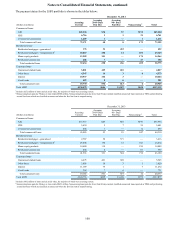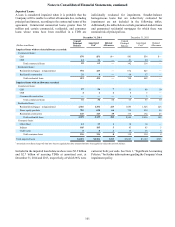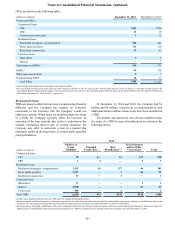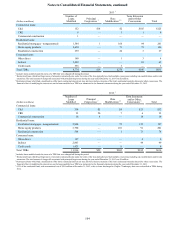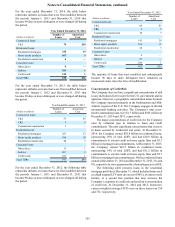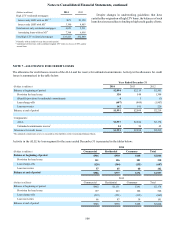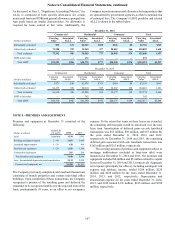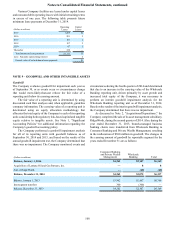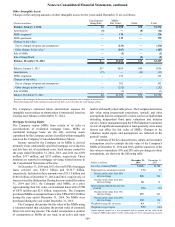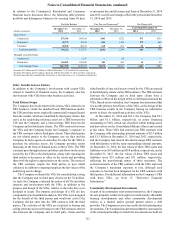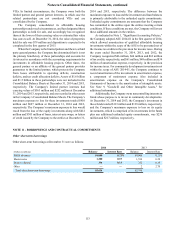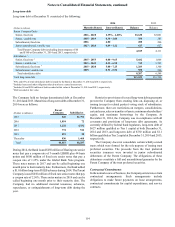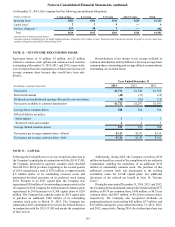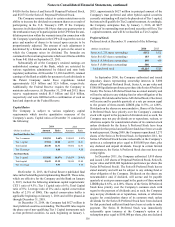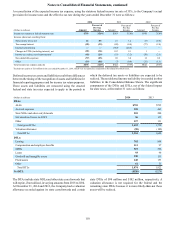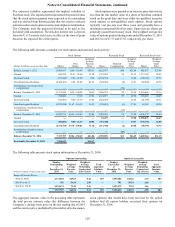SunTrust 2014 Annual Report Download - page 133
Download and view the complete annual report
Please find page 133 of the 2014 SunTrust annual report below. You can navigate through the pages in the report by either clicking on the pages listed below, or by using the keyword search tool below to find specific information within the annual report.Notes to Consolidated Financial Statements, continued
110
The above sensitivities are hypothetical and should be used with
caution. As the amounts indicate, changes in fair value based on
variations in assumptions generally cannot be extrapolated
because the relationship of the change in assumption to the
change in fair value may not be linear. Also, in this table, the
effect of a variation in a particular assumption on the fair value
of the retained MSRs is calculated without changing any other
assumption. In reality, changes in one factor may result in
changes in another, which might magnify or counteract the
sensitivities. Additionally, the sensitivities above do not include
the effect of hedging activity undertaken by the Company to
offset changes in the fair value of MSRs. See Note 17,
“Derivative Financial Instruments,” for further information
regarding these hedging activities.
NOTE 10 - CERTAIN TRANSFERS OF FINANCIAL ASSETS AND VARIABLE INTEREST ENTITIES
Certain Transfers of Financial Assets and Related Variable
Interest Entities
The Company has transferred loans and securities in sale or
securitization transactions in which the Company has, or had,
continuing involvement. All such transfers have been accounted
for as sales by the Company. Upon completion of transfers of
assets that satisfy the conditions to be reported as a sale, the
Company derecognizes the transferred assets and recognizes at
fair value any beneficial interests in the transferred financial
assets, such as trading assets or securities AFS, as well as
servicing rights retained and guarantee liabilities incurred. See
Note 18, “Fair Value Election and Measurement,” for further
discussion of the Company’s fair value methodologies.
The Company’s continuing involvement in such transfers
includes owning certain beneficial interests, including senior and
subordinate debt instruments, as well as equity interests,
servicing or collateral manager responsibilities, and guarantee
or recourse arrangements. Cash receipts on interests held related
to asset transfers were $21 million, $36 million and $30 million
for the years ended December 31, 2014, 2013, and 2012,
respectively. The servicing and management fees related to asset
transfers were immaterial for the years ended December 31,
2014, 2013, and 2012, respectively. The Company is not required
to provide additional financial support to any of the entities to
which the Company has transferred financial assets, nor has the
Company provided any support it was not otherwise obligated
to provide. Further, during the year ended December 31, 2014,
the Company evaluated whether any of its previous conclusions
regarding whether it is the primary beneficiary of the VIEs
described below should be changed based upon events occurring
during the period. These evaluations did not result in changes to
previous consolidation conclusions, except for one CLO entity
which is described in detail in the "Commercial and Corporate
Loans" section of this footnote. No events occurred during the
year ended December 31, 2014 that changed the Company’s sale
accounting conclusions in regards to previously transferred
residential mortgage loans, student loans, commercial and
corporate loans, or CDO securities.
When a transfer or other transaction occurs with a VIE, the
Company first determines if it has a VI in the VIE. A VI is
typically in the form of securities representing retained interests
in transferred assets and, at times, servicing rights and collateral
manager fees. If the Company has a VI in an entity, it then
evaluates whether or not it has both (1) the power to direct the
activities that most significantly impact the economic
performance of the VIE, and (2) the obligation to absorb losses
or the right to receive benefits that could potentially be significant
to the VIE to determine if the Company should consolidate the
VIE.
Below is a summary of transfers of financial assets to VIEs for
which the Company has retained some level of continuing
involvement:
Residential Mortgage Loans
The Company typically transfers first lien residential mortgage
loans in conjunction with Ginnie Mae, Fannie Mae, and Freddie
Mac securitization transactions whereby the loans are exchanged
for cash or securities that are readily redeemable for cash and
servicing rights are retained. The Company sold residential
mortgage loans to these entities, which resulted in pre-tax net
gains of $224 million, $186 million and $1 billion, including
servicing rights, for the years ended December 31, 2014, 2013,
and 2012, respectively. These net gains/losses are included
within mortgage production related income in the Consolidated
Statements of Income. These net gains/losses include the change
in value of the loans as a result of changes in interest rates from
the time the related IRLCs were issued to the borrowers but do
not include the results of hedging activities initiated by the
Company to mitigate this market risk. See Note 17, “Derivative
Financial Instruments,” for further discussion of the Company’s
hedging activities. As the seller, the Company has made certain
representations and warranties with respect to the originally
transferred loans, including those transferred under Ginnie Mae,
Fannie Mae, and Freddie Mac programs, and those
representations and warranties are discussed in Note 16,
“Guarantees.”
In a limited number of securitizations, the Company has
received securities representing retained interests in the
transferred loans in addition to cash (while also retaining
servicing rights) in exchange for the transferred loans. The
received securities are carried at fair value as securities AFS. At
December 31, 2014 and 2013, the fair value of securities received
totaled $55 million and $71 million, respectively, and were
valued using a third party pricing service.
The Company evaluated these securitization transactions
for consolidation under the VIE consolidation guidance. As
servicer of the underlying loans, the Company is generally
deemed to have power over the securitization entity. However,
if a single party, such as the issuer or the master servicer,
effectively controls the servicing activities or has the unilateral
ability to terminate the Company as servicer without cause, then
that party is deemed to have power over the entity. In almost all
of its securitization transactions, the Company does not have
power over the VIE as a result of these rights held by the master
servicer. In certain transactions, the Company does have power
as the servicer; however, the Company does not also have an
obligation to absorb losses or the right to receive benefits that
could potentially be significant. The absorption of losses and the


